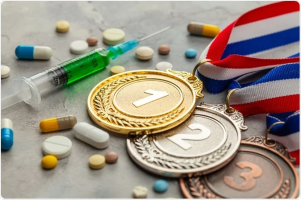BigArvin
Well-known member
Author
- Joined
- Aug 7, 2023
- Messages
- 379
- Points
- 28
Drug testing in sports is vital in ensuring fair competition and preserving the integrity of athletic achievements. It is a cornerstone for fostering trust among athletes, officials, and fans. However, the system has flaws, and controversies surrounding its implementation raise questions about fairness, ethics, and effectiveness.
Organizations like the World Anti-Doping Agency (WADA) play a critical role in establishing global standards for drug testing. Their efforts promote not only competitive integrity but also protect athletes from the potential health risks associated with PED abuse. By discouraging doping, these measures help maintain the spirit of sportsmanship.
Additionally, biological passport tracking plays a critical role in monitoring long-term biological data, allowing for detecting anomalies that may indicate doping.
New advancements, such as genetic doping detection and AI-assisted analysis, are pushing the boundaries of anti-doping efforts. However, as testing methods improve, so do the strategies of those attempting to evade detection. The continuous emergence of new PEDs remains a significant challenge.


The Russian Olympic doping scheme exposed state-sponsored efforts to manipulate drug testing. This scandal led to significant reforms, including stricter oversight and sanctions against non-compliant countries.
These incidents underscore the importance of accountability and vigilance in anti-doping efforts. They serve as reminders that even the most advanced systems require constant improvement.
Calls for reform continue, with stakeholders advocating for greater fairness, consistency, and respect for athletes’ rights in the anti-doping process.
Commonly tested substances include anabolic steroids, stimulants, human growth hormones, and blood doping agents like EPO.
How does WADA decide which substances to ban?
WADA evaluates substances based on three criteria: potential to enhance performance, risk to athlete health, and violation of the spirit of sport.
Can athletes challenge drug testing results?
Yes, athletes can appeal drug testing results through arbitration or court proceedings, often challenging the accuracy or fairness of the process.
The Purpose of Drug Testing in Sports
Anti-doping measures are designed to maintain a level playing field and uphold the principles of fair play. They aim to prevent athletes from gaining an unfair advantage through the use of performance-enhancing drugs (PEDs), ensuring that talent and hard work remain the primary determinants of success.Organizations like the World Anti-Doping Agency (WADA) play a critical role in establishing global standards for drug testing. Their efforts promote not only competitive integrity but also protect athletes from the potential health risks associated with PED abuse. By discouraging doping, these measures help maintain the spirit of sportsmanship.
Methods of Drug Testing
Urine tests are the most widely used method for detecting doping due to their reliability and cost-effectiveness. Blood tests, on the other hand, are particularly effective for identifying substances such as erythropoietin (EPO) and growth hormones.Additionally, biological passport tracking plays a critical role in monitoring long-term biological data, allowing for detecting anomalies that may indicate doping.
New advancements, such as genetic doping detection and AI-assisted analysis, are pushing the boundaries of anti-doping efforts. However, as testing methods improve, so do the strategies of those attempting to evade detection. The continuous emergence of new PEDs remains a significant challenge.
Major Controversies in Drug Testing
False Positives and Testing Accuracy
Errors in testing can lead to false positives, unfairly accusing athletes of doping. Such cases have devastated careers and reputations, even when the accusations are later overturned. High-profile examples highlight the need for greater accuracy and transparency in the process.
Selective Enforcement
Allegations of bias in drug testing enforcement have tarnished the credibility of anti-doping programs. Differences in regulations across sports and countries fuel perceptions of favoritism, creating an uneven playing field.Privacy Concerns
Athletes often feel that some testing methods' invasive nature infringes on their privacy. Striking a balance between rigorous testing and respecting individual rights remains contentious.
Missed Tests and Tampering
Instances of athletes avoiding or interfering with drug tests have raised questions about the effectiveness of anti-doping measures. High-profile cases involving tampering have exposed loopholes that undermine the system's credibility.Ethical Dilemmas in Drug Testing
Balancing the need for stringent anti-doping measures concerning athlete privacy poses a significant ethical challenge. Athletes under investigation often face stigma, regardless of the outcome. Additionally, debates persist about whether all performance enhancers should be banned or if some should be regulated, considering their potential medical or recovery benefits.Legal and Regulatory Challenges
The legal landscape of drug testing is fraught with disputes. Athletes have challenged WADA decisions in arbitration and courts, citing procedural errors or unfair treatment. Harmonizing anti-doping rules across different jurisdictions adds another layer of complexity, making enforcement inconsistent.The Evolution of Anti-Doping Efforts
High-profile doping scandals, such as Lance Armstrong’s confession and the Russian Olympic doping scheme, have significantly influenced anti-doping policies. Introducing biological passports and advanced detection methods has marked a shift towards more comprehensive testing. Efforts to enhance transparency and accountability within anti-doping agencies continue to evolve in response to public scrutiny.Case Studies of Controversial Drug Testing Incidents
Examples like sprinter Shelby Houlihan’s ban for a contaminated supplement illustrate the severe consequences of false positives. Such cases highlight the need for more robust testing protocols and appeals processes.The Russian Olympic doping scheme exposed state-sponsored efforts to manipulate drug testing. This scandal led to significant reforms, including stricter oversight and sanctions against non-compliant countries.
These incidents underscore the importance of accountability and vigilance in anti-doping efforts. They serve as reminders that even the most advanced systems require constant improvement.
The Future of Drug Testing in Sports
Technology advancements promise to improve the accuracy and reliability of drug testing. Artificial intelligence and machine learning are being explored to enhance detection methods. However, the rise of genetic doping presents new regulatory challenges that anti-doping agencies must address proactively.Calls for reform continue, with stakeholders advocating for greater fairness, consistency, and respect for athletes’ rights in the anti-doping process.
Frequently Asked Questions
What substances are commonly tested for in sports?Commonly tested substances include anabolic steroids, stimulants, human growth hormones, and blood doping agents like EPO.
How does WADA decide which substances to ban?
WADA evaluates substances based on three criteria: potential to enhance performance, risk to athlete health, and violation of the spirit of sport.
Can athletes challenge drug testing results?
Yes, athletes can appeal drug testing results through arbitration or court proceedings, often challenging the accuracy or fairness of the process.


















